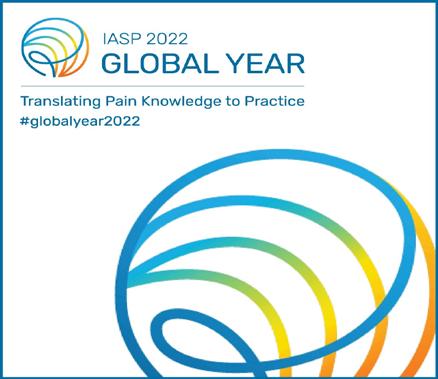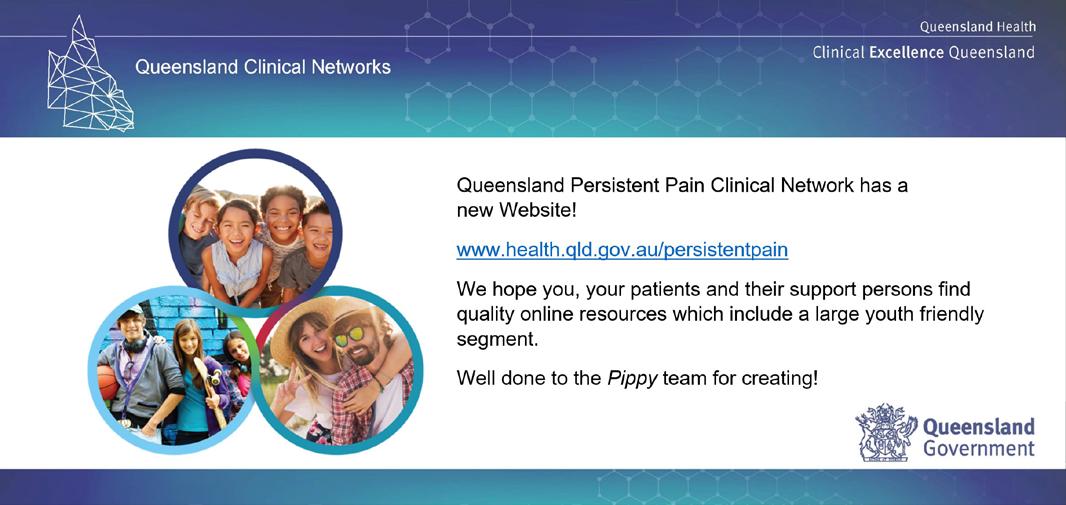
6 minute read
Communicating with children about ‘everyday’ pain and injury: A Delphi survey
from APS OCT22 eNews
by auspainsoc
Thank you to APS members Sarah Wallwork, Lorimer Moseley AO, and their colleague Melanie Noel for sharing the following recent publication.
Article first published online: July 13, 2022
Journal Reference: PAIN: Wallwork SB, Noel M, Moseley GL. Communicating with children about ‘everyday’ pain and injury: A Delphi study. Eur J Pain. 2022 Jul 13. doi: 10.1002/ ejp.2008. Epub ahead of print. PMID: 35829711.
DOI: https://doi.org/10.1002/ejp.2008
Abstract
Background
‘Everyday’ pain experiences are potentially critical in shaping our beliefs and behaviours around injury and pain. Influenced by social, cultural, and environmental contexts, they form the foundation of one’s understanding of pain and injury that is taken into adulthood. How to best communicate to young children about their everyday pain experiences, in order to foster adaptive beliefs and behaviours, is unknown.
Methods
In this Delphi survey, we sought expert opinion on the key messages and strategies that parents/caregivers can consider when communicating with young children (aged 2-7 years) about ‘everyday’ pain that is most likely to promote recovery, resilience and adaptive pain behaviours. Eighteen experts participated including specialists in paediatric pain, trauma, child development, and psychology; educators and parents. The survey included three rounds.
Results
Response rate was over 88%. Two hundred fifty-three items were raised; 187 reached ‘consensus’ (≥80% agreement among experts). Key messages that the experts agreed to be ‘very important’ were aligned with current evidence-based understandings of pain and injury. Strategies to communicate messages included parent/caregiver role-modelling, responses to child pain, and discussion during and/or after a painful experience. Other key themes included promoting emotional development, empowering children to use active coping strategies, and resilience building.
Conclusions
This diverse set of childhood, pain and parenting experts reached consensus on 187 items, yielding 12 key themes to consider when using everyday pain experiences to promote adaptive pain beliefs and behaviours in young children.
Implications/Discussion
BLOG WEB
Parents and caregivers likely play a critical role in the development of children’s fundamental beliefs and behaviours surrounding pain and injury that are carried into adulthood. Everyday pain experiences provide key opportunities to promote positive pain-related beliefs and behaviours. This Delphi survey identified key messages and strategies that caregivers can consider to optimise learning, encourage the development of adaptive pain behaviours, and build resilience for future pain experiences.
Declaration
GLM has received support from: Reality Health, ConnectHealth UK, Kaiser Permanente, AIA Australia, Workers’ Compensation Boards, and professional sporting organizations in Australia, Europe, and South and North America. Professional and scientific bodies have reimbursed him for travel costs related to presentation of research on pain at scientific conferences/symposia. He has received speaker fees for lectures on pain and rehabilitation. He receives royalties for books on pain and pain education. SBW and MN have no conflicts of interest.
SBW and GLM have received funding from NHMRC Leadership Investigator Grant awarded to GL Moseley ID1178444.
Thank you to APS members Edel O’Hagan, Adrian Traeger, Benedict Wand, Aidan Cashin, and James McAuley as well as their colleagues Siobhan Schabrun, Sean O’Neill, and Ian Harris for sharing the following recent publication.
Article first published online: 15 July 2022
Journal Reference: O’Hagan E, Traeger AC, Schabrun SM, O’Neill S, Wand BM, Cashin A, Williams CM, Harris IA, & McAuley JH. It’s safe to move! A protocol for a randomised controlled trial investigating the effect of a video designed to increase people’s confidence becoming more active despite back pain. BMJ Open 2022;12:e063250.
DOI: 10.1136/bmjopen-2022-063250
Abstract
Introduction
BLOG WEB
Social media provides promising contemporary platforms for sharing public health information with a broad audience. Recent research suggests that people with low back pain value learning about causes of low back pain, and people with low back pain who accept evidence-based messages, such as pain does not equal damage, are likely to intend to selfmanage their low back pain. Yet, inaccurate information is common in community healthcare settings and on health websites. Challenging unhelpful beliefs about low back pain was identified as one of the top 10 priorities for researchers, considered vital to reverse the alarming global rise in low back pain disability and healthcare costs.
One approach that has been successful at decreasing low back pain-related costs on a large scale are mass media campaigns that deliver a public health message to a broad audience. Before implementation, testing media campaigns that are intended to engage audiences and initiate behaviour change is necessary.
Objective
This trial aims to investigate the effectiveness of a public health campaign on social media at increasing people’s confidence becoming more active despite low back pain in comparison with no intervention.
Trial design
This trial is a three-group, parallel, randomised controlled trial (RCT) with two intervention groups and one control group in a 1:1:1 allocation.
Methods and analysis
People over 18 years of age and fluent in English will be recruited via social media advertising. Both video interventions follow the same narrative that scientists would like to reassure the public that low back pain is common, and that evidence suggests it is safe to move despite back pain
The featured scientists report that they are unsure of how to convey these messages to the public, which leads to designers at an advertising agency brainstorming how to help deliver the key message that it is safe to move. The advertising agency personnel suggest a dance. The video cuts back to the scientists who are reluctant to endorse one specific movement, such as a dance and conclude that it does not matter what you do as long as you move. The video ends with the superimposed text, ‘It’s safe to move’, ‘Your backbone has backbone’. The second video is the same as the first, except that when the advertising agency suggests the dance, the scientists try it out and to add humour, there are some video clips of the scientists dancing.
Participants in the control group will not view either video intervention.
The primary outcome will be item 10 of the Pain Self-Efficacy Questionnaire, which asks participants to rate how confident they would feel to gradually become more active despite pain. This outcome will be measured immediately in all participant groups. We will compare group mean of the three arms of the trial using univariate analyses of variance.
The secondary outcome will be Factor 1 of the AxEL-Q Questionnaire. The AxEL-Q is a questionnaire designed to assess attitudes toward education and advice for low back pain. We will conduct a qualitative evaluation to understand the helpfulness, engagement and the experience of watching the video.
Patient and public involvement
Consumers with low back pain were consulted throughout the design of the intervention process. Each major milestone of the intervention development was reviewed by members of the Musculoskeletal Health Consumer Community Council for Maridulu Budyari Gumal before proceeding to the next stage. The consumer group provided suggestions which were implemented in the revised versions including changes to the language used and written text superimposed in both videos.
This is a protocol; results are not available as yet.
Declaration
This project was funded by Maridulu Budyari Gumal. Edel O’Hagan has nothing to declare.
Have you had an article accepted for publication recently?
The Australian Pain Society (APS) is keen to share publications from our members with their colleagues via our eNewsletter. If you’ve had an article accepted or published recently, please contact our Assistant Editor Joanne Harmon via the APS Secretariat (aps@apsoc.org.au) with the title, authors, and reference (i.e., journal, volume, and DOI) of your article and request the submission template. We would love it if you also supply a short commentary (300 words max) to give our readers the gist of the article.
Thank you to APS members Damien Boorman and Kevin Keay for sharing the following recent publication.
Article first published online: 19 July 2022
Journal Reference: Boorman DC & Keay KA (2022) Sex differences in morphine sensitivity are associated with differential glial expression in the brainstem of rats with neuropathic pain. Journal of Neuroscience Research, 00, 1– 18.
DOI: 10.1002/jnr.25103
Abstract
Introduction
Chronic pain is more prevalent and reported to be more severe in women. Opioid analgesics are less effective in women and result in stronger nauseant effects. The neurobiological mechanisms underlying these sex differences have yet to be clearly defined, though recent research has suggested neuronal–glial interactions are likely involved. We have previously shown that similar to people, morphine is less effective at reducing pain behaviors in female rats.
BLOG WEB including the rostral ventromedial medulla (RVM), the subnucleus reticularis dorsalis (SRD), the gracile nuclei, and the area postrema.
Results
Morphine administration had small sexdependent effects on overall GFAP expression, but not on astrocyte morphology, in the RVM, the SRD, and the area postrema. Significant sex differences in the density and morphology of GFAP immunopositive astrocytes were detected in all regions of interest. In general, GFAPpositive cells in females showed smaller volumes and reduced complexity than those observed in males. Furthermore, females showed lower overall GFAP expression in all regions except for the area postrema, the critical medullary region responsible for opioid-induced nausea and emesis.
Conclusions
These data support the possibility that differences in astrocyte activity might underlie the sex differences seen in the processing of opioids in the context of chronic neuropathic pain.
Implications/Discussion
Methods
This study investigates the expression of astrocytes in brainstem regions involved in the modulation of pain and the processing of opioids in female and male rats with neuropathic injury. We used the immunohistochemical detection of glial fibrillary acidic protein (GFAP) expression to investigate sex differences in astrocyte density and morphology in several medullary regions
These data implicate differences in astrocyte activity as a contributing factor in the commonly observed sex differences in the analgesic and emetic effects of opioids seen in both clinical and preclinical studies.
Declaration
Damien Boorman and Kevin Keay have nothing to declare.




